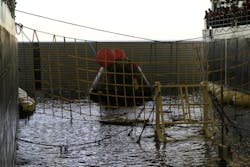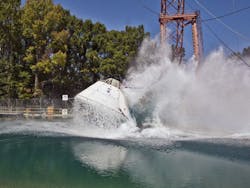NASA’s Orion spacecraft successfully completed its inaugural voyage last Friday when it was recovered by the U.S. Navy’s USS Anchorage, following its splashdown in the Pacific Ocean. NASA reports that Orion was launched into space on a two-orbit, 4.5-hour test flight at 7:05 am EST on December 5. NASA, the Navy, and Orion prime contractor Lockheed Martin will perform an initial checkout of Orion while the Anchorage transports the spacecraft back to shore. It is expected to be offloaded at Naval Base San Diego on Monday.
Prior to the launch, DTS (Diversified Technical Systems) described how its data recorders helped prepare Orion for the splashdown. The company put it this way:
“It’s no simple task to travel 3,600 miles into space, blaze back through Earth’s atmosphere at 20,000 mph with temperatures approaching 4,000°F, and then splash-land into the Pacific Ocean. That’s why NASA has spent three years dropping the 18,000-pound Orion mockup space capsule into a special test pool all wired up with hundreds of sensors, strain gauges, and accelerometers to measure stresses and structural integrity….”
The company adds that in a series of splashdown tests at the Hydro Impact Basin at Langley Research Center, NASA engineers employed DTS data recorders and software to capture all the action as they simulated different water landing scenarios that Orion could face.
DTS said its systems are small and lightweight so they fit onboard and run autonomously during testing, and they are sufficiently rugged that they can survive harsh impacts (like crashing and blasting) and still deliver accurate data.
“Being a part of NASA’s Orion space vehicle testing at Langley has been an extremely gratifying experience for DTS,” said Mike Beckage, DTS cofounder and chair of Lowell Observatory’s advisory board. “We’re proud to know that the data collected with our systems help make space exploration safer.”



